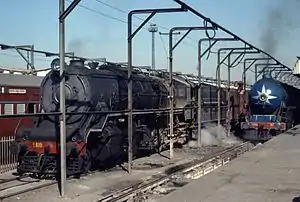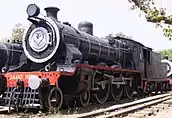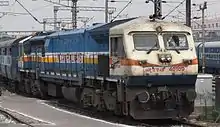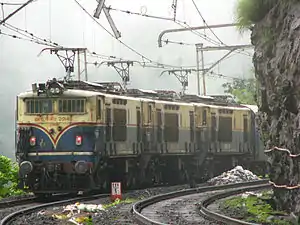Indian locomotive class WG
The Indian Railways WG class was a type of broad gauge 2-8-2 goods locomotive introduced in the 1950s. 2450 of the class were built between 1950 and 1970.
| Indian WG | |||||||||||||||||||||||||||||||||||||
|---|---|---|---|---|---|---|---|---|---|---|---|---|---|---|---|---|---|---|---|---|---|---|---|---|---|---|---|---|---|---|---|---|---|---|---|---|---|
 WG class (left) at Agra station (2007) | |||||||||||||||||||||||||||||||||||||
| |||||||||||||||||||||||||||||||||||||
| |||||||||||||||||||||||||||||||||||||
| |||||||||||||||||||||||||||||||||||||
| |||||||||||||||||||||||||||||||||||||
| Sources :[3] except where noted | |||||||||||||||||||||||||||||||||||||
History and design
The WG design was introduced in 1950; it utilised identical equipment (boiler, motion, springs, tender bogies, and rear truck) as used in the 4-6-2 WP class passenger locomotives. The first hundred units (No.s 8301 to 8400) were built by North British and subcontractor Vulcan Foundry (ten units). Number 8350 was exhibited at the Festival of Britain in 1951.[4]
Locomotives were also sourced from the Société Franco-Belge in Raismes, France,[5] Lokomotivfabrik Floridsdorf in Austria,[6] and from elsewhere in Europe and from Japan. The rolling stock works of Chittaranjan Locomotive Works in West Bengal initially manufactured locomotives from imported parts; by 1953, 70% of the locomotives were domestically produced, and by 1956 the works was able to entirely satisfy the domestic production need for WG locomotives. Production ceased in 1970; the final unit being named Antim Sitara (Last Star).[5]
Preservation
Nine WG's are now preserved in India, WG 9673 is preserved on a pedestal (without its tender) outside Rajendra Nagar Station New Delhi, WG 10253, is preserved at the Zonal Training School Bhusaval, WG 9428 is used at the UP Cement Corporation, WG 9391 is preserved and stored in Burdwan, WG 8258 is preserved on a static pedestal on public display in Sahibganj railway station, WG 10527 is stored in a shed in Burdwan, WG 9286 is preserved by Sri Durga Trading Company, WG 8407 "Deshbandhu" became the first WG to be preserved into Indian Railway Heritage, it is stored Pedestal along with WG 10560 "Antim Sitara" at Chittaranjan Locomotive Works.
See also
References
Notes
- Hughes 1996, p. 19.
- Hughes 1996, p. 110.
- Indian Steam Pages - Post War Steam, IRFCA
- Indian Steam Pages - Post War Steam, IRFC, Development of post war standard goods locomotive
- Indian Steam Pages - Post War Steam, IRFC, Building locomotives at Chittaranjan
- Ingrid Trummer; Alexander Stollhof (2005), Bei uns in der Lofag.. - Erinnerungen an die Floridsdorfer Lokomotivfabrik – Wiens größten Industriebetrieb (PDF), EDITION VOLKSHOCHSCHULE, Verband Wiener Volksbildung und Volkshochschule Floridsdorf, ISBN 3-900799-67-9
External links
| Wikimedia Commons has media related to Indian locomotive class WG. |
- "Indian Railways, 5ft 6in Gauge, 1951, 2-8-2 (WG)- Vulcan Foundries" (PDF), www.enuii.org
- "Indian Steam Pages - Post War Steam", www.irfca.org, IRFC, Indian Railways Fan Club, retrieved 2 March 2012




